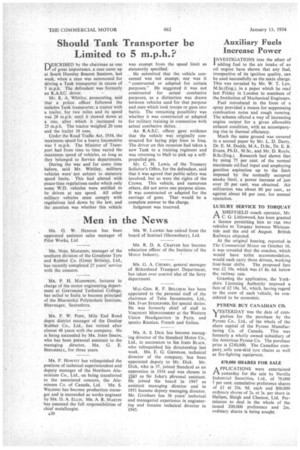Should Tank Transporter be Limited to 5 m.p.h.?
Page 32

If you've noticed an error in this article please click here to report it so we can fix it.
DESCR1BED by the chairman as one of great importance, a case came up at South Hunsley Beacon Sessions, last week, when a man was summoned for driving a Tank transporter in excess of 5 m.p.h. The defendant was formerly an R.A.S.C. driver.
Mr. R. A. Whitley, prosecuting, said that a police officer followed the unladen Tank transporter, a tractor with a trailer, for two miles and its speed was 28 m.p.h. until it slowed down at a rise, after which it increased to 25 m.p.h. The tractor weighed 20 tons and the trailer 10 tons.
Under the Road Traffic Act, 1934, the maximum speed for a heavy locomotive was 5 m.p.h. The Minister of Transport had from time to time varied the maximum speed of vehicles, so long as they belonged to Service departments.
During the war and for some time before, said Mr. Whitley, military vehicles were' not subject to statutory speed limits. This had altered with peace-time regulations under which only some W.D. vehicles were entitled to be driven at any speed. All other military vehicles must comply with regulations laid down by the law, and the Question was whether this vehicle was exempt from the speed limit as statutorily specified.
He submitted that the vehicle concerned was not exempt, nor was it "constructed or adapted for certain purposes." He suggested it was not constructed for actual combative purposes„ as a distinction was drawn between vehicles used for that purpose and ones which took troops or guns into battle. The remaining possibility was whether it was constructed or adapted for military training in connection with actual combative duties.
An R.A.S.C. officer gave evidence that the vehicle was originally constructed for laying pipe lines in Iraq. The driver on this occasion had taken a new Tank to a training regiment and was returning to Hull to pick up a selfpropelled gun.
Mr. C. H. Lewis, of the Treasury Solicitor's Office, for the defendant, said that it was agreed that public safety was involved, but so were the rights of the Crown. This vehicle, and numerous others, did not serve one purpose alone. It was constructed or adapted for the carriage of guns. That would be a complete answer to the charge.
Judgment was reserved.




































































































